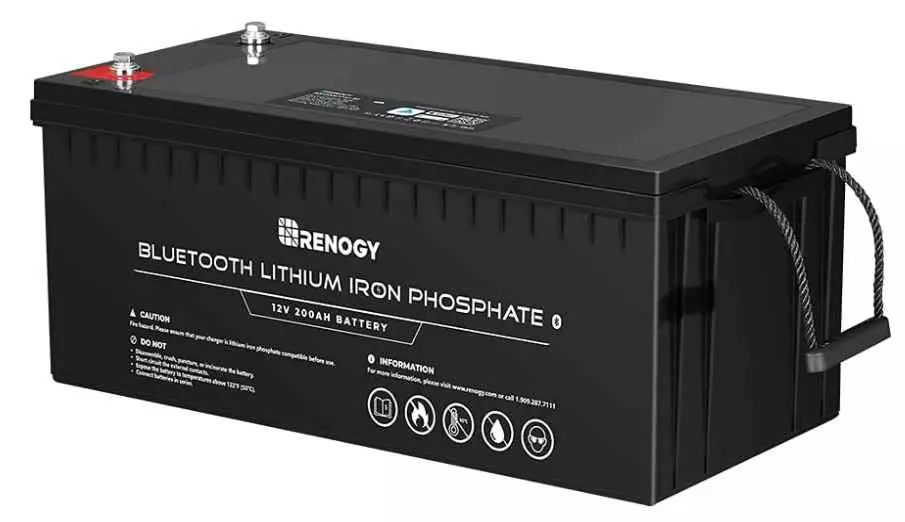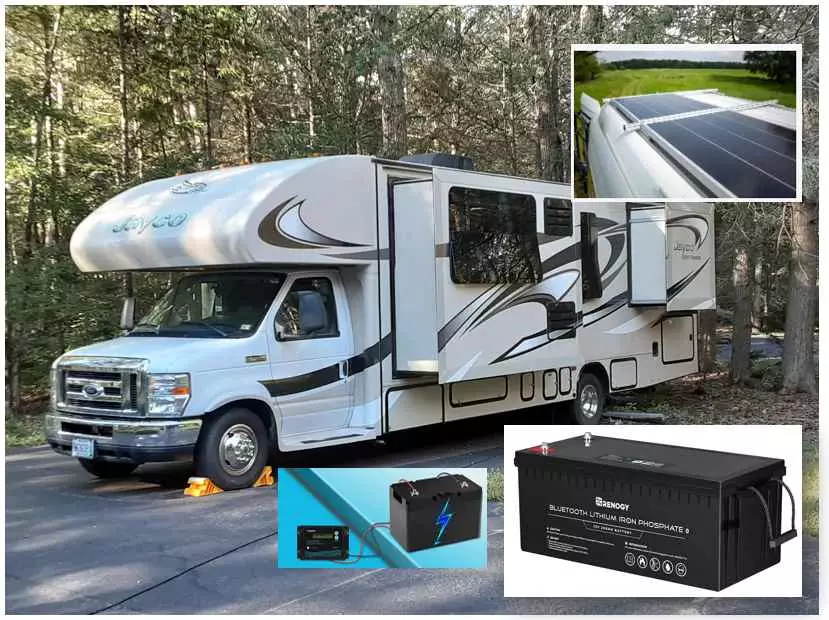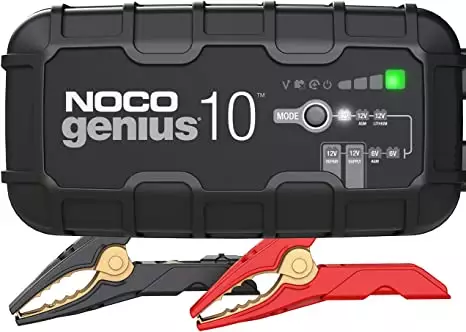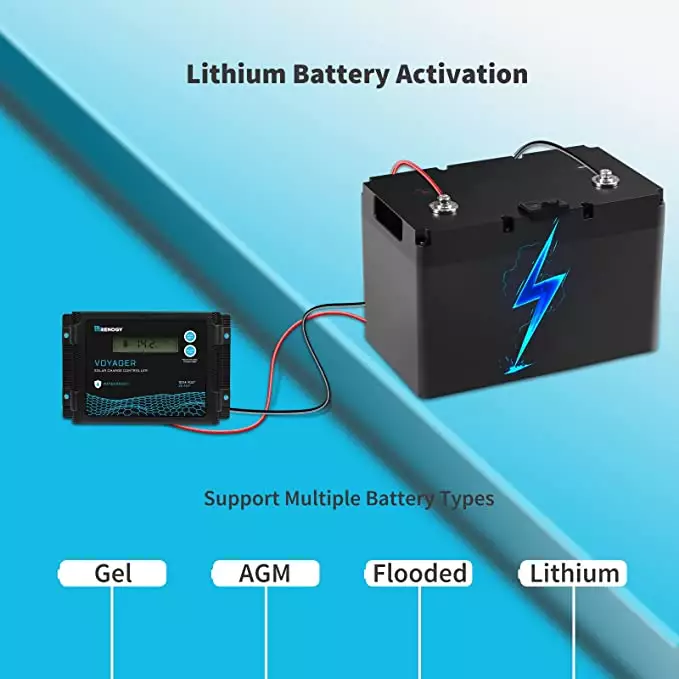In this article, I will explain the two most straightforward ways to charge an RV deep-cycle battery. The methods I will explain here allow you to take care of the life of the deep-cycle battery and are under the safe practices proposed by the manufacturers. Let’s see How To Charge A Deep Cycle Battery for your RV and camping activities. Also, I included a 2-minute video showing How to Connect the solar panel, the deep cycle RV battery, and the charge controller.
Before I begin, let me make it clear that if you have a deep cycle battery that is both RV and marine, the options for charging the battery are the same and will all be reviewed in this article. Also, let me clarify that if you have a battery in your camper that commercially meets the description “RV battery for starting and deep cycle“, how to charge a deep cycle RV battery that is also used for starting is also included in this article. Not all campers use this type of battery in their configuration.

Photo source: https://renogy.com/
Table of Contents
How To Charge A Deep Cycle RV Battery
How To Charge A Deep Cycle RV Battery? It seems that this topic always generates complexity when we are in our RV and we want to use solar energy, generator, starting batteries, deep cycle batteries, inverters, etc., and we go crazy trying to do calculations without understanding if all the energy we have will work for us and how we can use it within the budget. Besides, deep cycle batteries, and I mean the good, good quality ones, are not cheap, so one seeks to take care of them and take advantage of them as long as possible, right? I bet this situation explained also happened to you.
So, I prepared a series of articles at the request of our readers explaining everything about charging, maintenance, and selection of deep cycle batteries for RVs. I will explain it in an easy way (or at least I will try to) without going deep into details.
Choose the Power Source (Electricity or Solar?)
To charge a deep-cycle battery, we will always need a power source and a converter to the voltage of our battery. As I mentioned earlier, I will only mention options that will maintain the life of a deep-cycle battery (no weird or unsafe stuff).
We have two power source options:
1. AC power, electricity at home or RV park where we are parked.
2. Solar energy from a solar panel (solar DC power) through a solar charge controller.
To use either of these two forms of energy to charge a deep-cycle battery for an RV, we will need a deep-cycle battery charger.
Can we use a standard battery charger to charge a deep-cycle RV battery? No, it is not recommended. You will significantly shorten the life cycle of your deep cycle battery, and you don’t want to find yourself in the middle of nowhere with one less deep cycle battery or without the only deep cycle battery you have in the RV. Therefore, I strongly recommend employing the right deep-cycle battery charger for your RV battery.
Battery Charger Selection
As mentioned in the previous paragraph, we must be sure that we are acquiring and using a suitable battery charger to charge a deep-cycle battery according to the energy source we are interested in using.
The variables to consider are the following when choose the correct deep-cycle battery charger:
- Deep cycle RV battery materials that can be charged (designed to charge lead-acid batteries, including lithium (LiFePO4), wet (flooded), gel, MF (maintenance-free), AC (calcium), EFB (enhanced flooded battery), and AGM (absorption glass mat), 6V and 12V batteries.
- Capacities are suitable for our deep-cycle battery. Charge battery capacities up to 230 ampere-hours and maintain all battery sizes.
Only use specific deep cycle battery chargers with the proper chemistry for the charger and the properly specified voltages (you will always find this information available from both the battery manufacturer and the charger manufacturer).
Deep cycle battery chargers are electronically controlled to supply deep cycle batteries (either RVs, marine, deep only, or with combined starting and deep cycle function in a single battery) with a series of charging steps.
A regular battery charger is not equipped to handle the unique needs of deep cycle battery charging and is risky to use. In addition, the use of an ordinary battery charger can shorten the life of a deep-cycle battery.
When choosing a deep cycle battery charger, make sure that it is suitable for deep cycle batteries with the information mentioned in the previous bullet point.
In addition, you can calculate how much charging time will be needed for your battery by consulting the specifications or if you are interested in having the same charger charge several batteries at the same time.
The size of the battery (amp/hour) and its depth of discharge considerably affect its charging time. Roughly consider that a deep cycle battery charger will take 1.5 hours to charge 20 amp/hour of a deep cycle RV battery (6V or 12V), and just under 18 hours to charge 230 amp/hour. If these times don’t seem adequate for your purposes, consider charging times when choosing a deep-cycle battery charger.
Marine deep cycle battery chargers are a good choice for RV. Marine battery chargers are equipped with water protection but can perform the same functions as mentioned above if the battery to be charged has the proper chemistry. In general, they are a bit more expensive because they are completely waterproof and can be placed anywhere on the boat. Some electrical mounting rings that may be directly connected to the battery terminals are included with these chargers.

Charging a Deep Cycle Battery For Your RV – Step by Step
In the following paragraphs, I will explain step by step how to charge a deep cycle battery with DC and solar panels.
- Install the deep-cycle battery charger according to the manufacturer’s instructions.
- Verify that the RV battery chemistry is adequate. And review the charger and battery manufacturer’s safety instructions.
- Connect the red positive (+) cable from the charger to the positive terminal of the deep cycle RV battery or battery pack. Make sure that the connection is clean, tight, and free of any dirt. The edges of the battery should be clean.
- Attach the black negative (-) cable from the charger to the negative terminal on the deep cycle RV battery or battery pack. Again, make sure that the connection is clean and tight.
- The charger and the battery or batteries should be placed away from each other. Do not place the battery or the charger one on top of the other. And everything must be separated from the ground connection. All manufacturers mention important safety instructions that I advise you to review and understand to avoid accidents.
Charge A Deep Cycle Battery with AC Power at Home or in an RV Park
- Make sure that you have connected the jumper wires or round terminal connectors correctly and that the AC power cord is plugged into the power outlet.
- The charger should be turned on.
- Two LED indicators are located on the charger’s front for the majority of applications. The machine is receiving the 120 VAC supply, as indicated by the green LED indication. The red LED shows that the batteries are receiving electricity.
- If, for some reason, you see a flashing red LED, refer to the battery charger requirements. This indicates a problem with the charger or the batteries. The red LED’s flashing codes vary across manufacturers. An indication that the batteries are completely charged is when the red LED goes off, but the green LED remains on. The green LED is on, and the charger is slowly and consistently charging the batteries. There is no risk of overcharging deep-cycle batteries if the right charging device is used.

Photo source: https://no.co/genius10
In the market, there are good deep-cycle battery chargers. I use this one with AC power (NOCO GENIUS10, 10A Fully-Automatic Smart Charger, 6V, and 12V) because it is very versatile, small, affordable, and has different options to charge batteries of different materials. Very good value for money. Also, the charging times are adequate for me. Check out the user guide for this battery charger (User guide available at https://no.co/genius10)
Current Comparison of the Best Pure Sine Wave Inverter for RV
Charge A Deep-Cycle Battery with a Solar Panel (DC Power)
- Once you have connected the positive and negative of your deep cycle battery to the charger, you will need to connect the positive and negative of the solar panel to your battery charger.
- Be sure to use the proper setting for the voltage and chemical material of the battery.
- The solar battery charge controller will convert the DC power from your solar panel for your deep cycle RV battery.

Photo source and Spec: https://renogy.com/
This is the deep-cycle battery charger that I recommend for solar battery charging. The Renogy Voyager 20A 12V/24V PWM Waterproof Solar Charge Controller w/ LCD Display. I’ve been using it for a while now, and I find it versatile, compatible with all types of batteries I’ve been looking to charge, and with both RV and home solar panels. So, I like it enough to recommend it. The cost-performance ratio is excellent.
I am leaving you with the video of how to connect the battery, the panel, and the solar charge controller, and I am sure you will choose it because it is straightforward to use. In only 2-minute videos, you will see how easy it is to use and connect it. Definitely, this little guy simplified my camper connections.
Warnings
Remember to read the manufacturers’ instructions and safety warnings. Do not charge batteries in well-ventilated areas, as they may cause the emission of flammable gases that can be highly explosive. Keep any battery away from open flame. Charging other battery chemicals may cause injury, death, or property damage. Do not charge a battery if you are unsure of the specific battery chemistry or voltage.
If you are not using any recommended deep cycle battery charger recommended here, keep in mind the following when choosing a charger or a charge controller as the chemistry of the deep cycle RV battery must be suitable for the charger.
The full charge voltage of most lead-acid batteries is 13.8V or 2.3V per cell (6 cells). Cells in sealed lead-acid batteries (SLA) have the unusual ability to balance themselves. As a result, lead-acid chargers only need to supply a voltage greater than the battery’s voltage to charge a battery (13.8V) fully.
The majority of lead-acid smart chargers offer three stages of charging: bulk, absorption, and float, each with a distinct purpose. Each type of deep-cycle battery has a specific voltage because its chemistries have different energy densities.
The voltage of LiFePO4 is 14.6V or 3.65V per cell (4 cells). When this battery is drained, an SLA charger will read 13.8V from it and believe it is completely charged even when it is not, yielding disappointing capacity. Some chargers may even skip the bulk and absorption stages in favor of float charging, which effectively prevents the battery from receiving any power because the charger assumes the battery is fully charged. Don’t forget that certain SLA smart chargers equalize the battery’s cells, which harms the LiFePO4 cells as well!
Last Recommendation – How to Choose the Best Deep Cycle Battery for RVs? Read this article and get the most cost-benefit value. You will find out in this article how to determine which battery is the best. We found these 2 deep cycle batteries as the best ones for RVs.
Conclusion
I hope I have done my best to keep this article about “How to Charge a Deep Cycle RV Battery” short and sweet. Charging deep cycle batteries for your RV is a simple and, I would even say, routine task. My advice is don’t make it complicated by creating unsafe situations, and be safe when hitting the road!
